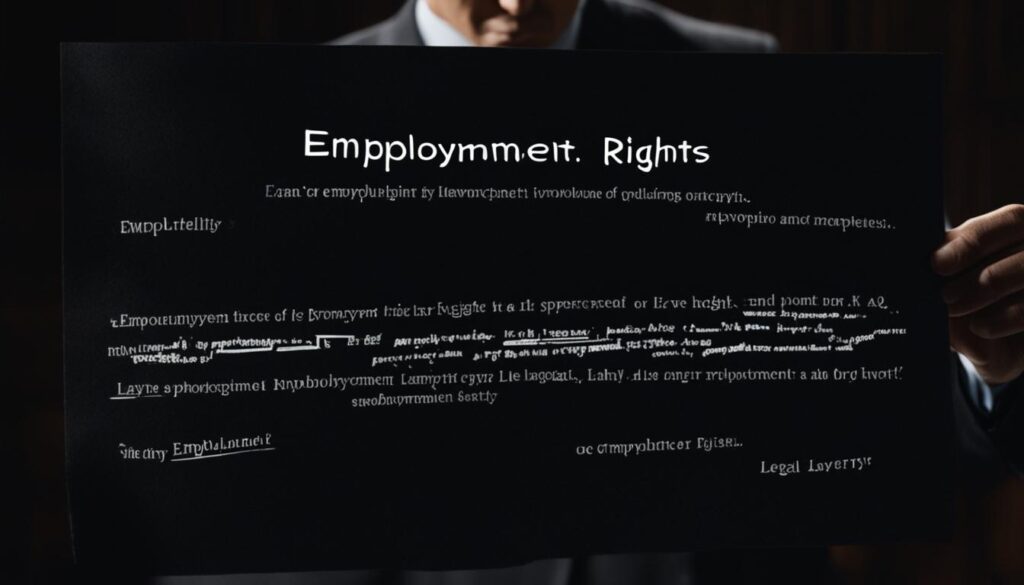Are you looking for ways to boost your business and contribute to the job market recovery? The Hiring Incentives to Restore Employment (HIRE) Act provides the perfect solution. With its range of hiring incentives, this act aims to stimulate economic growth, reduce unemployment, and restore employment opportunities. By taking advantage of the HIRE Act, you can give your business a competitive edge while positively impacting the job market.
Under the HIRE Act, employers are offered a payroll tax holiday and business credits for hiring and retaining new employees. Additionally, the act emphasizes infrastructure investment and promotes hiring in the public sector. By providing tax incentives for hiring, retaining workers, and investing in new equipment, the HIRE Act creates an environment conducive to job creation and economic expansion.
Key Takeaways:
- The HIRE Act offers hiring incentives through payroll tax holidays and business credits.
- Employers can benefit from a payroll tax holiday when hiring unemployed workers.
- Rewarding employers with tax credits for retaining workers for a specific duration is another advantage of the HIRE Act.
- Small and large businesses, tax-exempt organizations, and certain educational and government institutions are eligible for these incentives.
- The HIRE Act includes provisions for infrastructure investment and foreign account compliance.
Payroll Tax Holiday for Hiring Unemployed Workers
The HIRE Act offers a valuable opportunity for employers to benefit from a payroll tax holiday when they hire unemployed workers in 2010. This special tax holiday serves as an incentive for businesses to increase their workforce and contribute to the overall recovery of the job market. By taking advantage of this tax holiday, employers can save on payroll taxes and reinvest those funds into their operations.
The payroll tax holiday forgives the employer’s share of the old age, survivors, and disability insurance (OASDI) payroll tax for certain eligible individuals. This means that employers are temporarily exempted from paying their share of the OASDI tax for the wages earned by these newly hired unemployed workers.
To qualify for this tax holiday, individuals must meet specific criteria. They must certify that they have not been employed for more than 40 hours in the 60 days prior to starting employment with the qualified employer. This requirement ensures that employers are hiring individuals who have faced challenges in finding employment and provides them with an opportunity to rejoin the workforce.
The payroll tax holiday applies to wages paid between March 19, 2010, and December 31, 2010. During this period, employers can avail themselves of the tax benefits provided by the HIRE Act and actively contribute to reducing unemployment rates. By hiring unemployed workers, businesses can not only fulfill their staffing needs but also make a positive impact on the lives of individuals seeking employment.
Tax Credit for Retained Workers
The HIRE Act offers a beneficial tax credit for employers who retain their workers. This tax credit can amount to up to $1,000 for each retained worker, providing significant financial relief for businesses. A retained worker, as defined by the act, refers to an employee who has been continuously employed by the taxpayer for at least 52 weeks.
The eligibility for the tax credit is based on the wages earned by the retained worker during the last 26 weeks of their employment. If the wages for this period equal or exceed 80% of the wages earned during the first 26 weeks, the employer can claim the tax credit. The actual credit is calculated as the lesser of $1,000 or 6.2% of the wages paid to the retained worker over the entire 52-week period.
It is important to note that this tax credit applies to both large and small employers, allowing businesses of all sizes to benefit from retaining their valuable workforce. By taking advantage of this tax credit, employers can not only save money but also demonstrate their commitment to supporting their employees.
Eligibility and Requirements
For employers to qualify for the hiring incentives under the HIRE Act, they must meet specific eligibility criteria. To be eligible, employers can be a small or large business, tax-exempt organization, public college or university, Indian tribal government, or farmer. However, household employers and federal, state, and local government employers, other than public colleges and universities, are not eligible for these incentives.
On the other hand, to be considered a qualified employee, individuals must meet certain requirements. They should commence their employment after February 3, 2010, and before January 1, 2011. Additionally, these individuals should either be unemployed or have worked for 40 hours or less in the previous 60 days. Employers are required to obtain a signed affidavit from new hires, certifying their employment status.
By meeting these eligibility and requirements, both employers and employees can benefit from the hiring incentives provided under the HIRE Act.
Other Provisions of the HIRE Act
In addition to the hiring incentives provided by the HIRE Act, there are several other provisions that aim to stimulate economic growth and enhance compliance in the financial sector.
Extension of Section 179 Expense Deduction Limit
The HIRE Act extends the Section 179 expense deduction limit, allowing businesses to deduct the full cost of qualifying equipment and software purchased or financed during the tax year. This provision helps incentivize businesses to invest in necessary resources, such as machinery, technology, and infrastructure, which can contribute to increased productivity and overall growth.
Authorization of Funding for Highway and Transit Projects
To support infrastructure development and create job opportunities, the HIRE Act authorizes funding for highway and transit projects. This funding allows for the improvement and expansion of transportation networks, ensuring the efficient movement of goods and people across the country. These initiatives not only address critical infrastructure needs but also provide a platform for economic progress and connectivity.
Reforms to Municipal Bonds
The HIRE Act introduces reforms to municipal bonds, which are typically issued by state and local governments to raise funds for public projects. These reforms aim to enhance transparency and ensure appropriate use of funds, contributing to the overall efficiency and effectiveness of public financing initiatives. By strengthening the integrity of municipal bonds, the HIRE Act supports sustainable development and responsible fiscal management.
Foreign Account Compliance through FATCA
The HIRE Act includes provisions for foreign account compliance through the Foreign Account Tax Compliance Act (FATCA). FATCA requires foreign banks to disclose information about American account holders to the Internal Revenue Service (IRS) to ensure compliance with tax laws. This measure helps prevent tax evasion and promotes transparency in offshore financial activities. However, European banks’ implementation of FATCA has resulted in the closure of brokerage accounts for many US customers.
These additional provisions of the HIRE Act demonstrate the comprehensive approach taken to stimulate economic growth, promote infrastructure investment, and ensure compliance in the financial sector. While they contribute to overall progress, it is crucial to consider the potential implications and challenges associated with foreign account compliance measures.

Conclusion
The Hiring Incentives to Restore Employment (HIRE) Act provides vital incentives for employers to contribute to job market recovery and employment stimulus in the United States. By taking advantage of the payroll tax holiday and tax credit provisions, businesses can play a pivotal role in reducing unemployment and fostering workforce development.
Under the HIRE Act, employers are rewarded for hiring and retaining workers, which not only helps individuals secure employment but also fuels economic growth. The act’s focus on addressing infrastructure investment and foreign account compliance further strengthens the country’s employment landscape.
By leveraging the hiring incentives provided by the HIRE Act, businesses have the opportunity to make a significant impact on job market recovery. These incentives not only benefit employers but also contribute to the overall growth and stability of the economy. Through the collaborative efforts of employers, employees, and the government, we can build a stronger workforce and pave the way for a prosperous future.
FAQ
What is the Hiring Incentives to Restore Employment (HIRE) Act?
The HIRE Act provides payroll tax holiday and business credit incentives for employers to hire and retain new employees. It also includes provisions for infrastructure investment and hiring in the public sector.
What is the payroll tax holiday under the HIRE Act?
The payroll tax holiday forgives the employer’s share of the old age, survivors, and disability insurance (OASDI) payroll tax for certain eligible individuals who are unemployed and hired by qualified employers in 2010.
How long does the payroll tax holiday apply?
The payroll tax holiday applies to wages paid between March 19, 2010, and December 31, 2010.
What is the tax credit for retained workers under the HIRE Act?
The tax credit is up to
FAQ
What is the Hiring Incentives to Restore Employment (HIRE) Act?
The HIRE Act provides payroll tax holiday and business credit incentives for employers to hire and retain new employees. It also includes provisions for infrastructure investment and hiring in the public sector.
What is the payroll tax holiday under the HIRE Act?
The payroll tax holiday forgives the employer’s share of the old age, survivors, and disability insurance (OASDI) payroll tax for certain eligible individuals who are unemployed and hired by qualified employers in 2010.
How long does the payroll tax holiday apply?
The payroll tax holiday applies to wages paid between March 19, 2010, and December 31, 2010.
What is the tax credit for retained workers under the HIRE Act?
The tax credit is up to $1,000 for each retained worker. A retained worker is defined as an employee who was employed by the taxpayer for at least 52 consecutive weeks and whose wages during the last 26 weeks equaled at least 80% of the wages for the first 26 weeks.
Who is eligible for the hiring incentives under the HIRE Act?
Eligible employers include small or large businesses, tax-exempt organizations, public colleges or universities, Indian tribal governments, and farmers. Household employers and federal, state, and local government employers, other than public colleges and universities, are not eligible.
Who is considered a qualified employee under the HIRE Act?
Qualified employees are those who begin employment after February 3, 2010, and before January 1, 2011, and have been unemployed or worked 40 hours or less in the previous 60 days.
What are the other provisions of the HIRE Act?
The HIRE Act also extends the Section 179 expense deduction limit, authorizes funding for highway and transit projects, makes reforms to municipal bonds, and addresses foreign account compliance through the Foreign Account Tax Compliance Act (FATCA).
How can businesses leverage the hiring incentives under the HIRE Act?
By taking advantage of the payroll tax holiday, tax credits for retained workers, and other provisions, businesses can contribute to job market recovery, stimulate workforce development, and play a vital role in the employment stimulus in the United States.
,000 for each retained worker. A retained worker is defined as an employee who was employed by the taxpayer for at least 52 consecutive weeks and whose wages during the last 26 weeks equaled at least 80% of the wages for the first 26 weeks.
Who is eligible for the hiring incentives under the HIRE Act?
Eligible employers include small or large businesses, tax-exempt organizations, public colleges or universities, Indian tribal governments, and farmers. Household employers and federal, state, and local government employers, other than public colleges and universities, are not eligible.
Who is considered a qualified employee under the HIRE Act?
Qualified employees are those who begin employment after February 3, 2010, and before January 1, 2011, and have been unemployed or worked 40 hours or less in the previous 60 days.
What are the other provisions of the HIRE Act?
The HIRE Act also extends the Section 179 expense deduction limit, authorizes funding for highway and transit projects, makes reforms to municipal bonds, and addresses foreign account compliance through the Foreign Account Tax Compliance Act (FATCA).
How can businesses leverage the hiring incentives under the HIRE Act?
By taking advantage of the payroll tax holiday, tax credits for retained workers, and other provisions, businesses can contribute to job market recovery, stimulate workforce development, and play a vital role in the employment stimulus in the United States.




